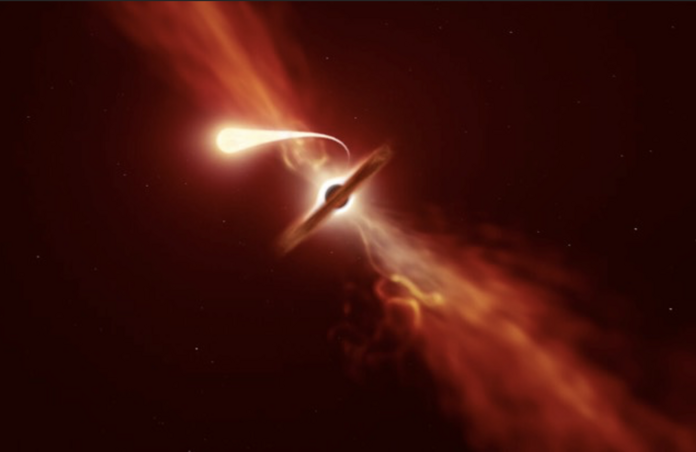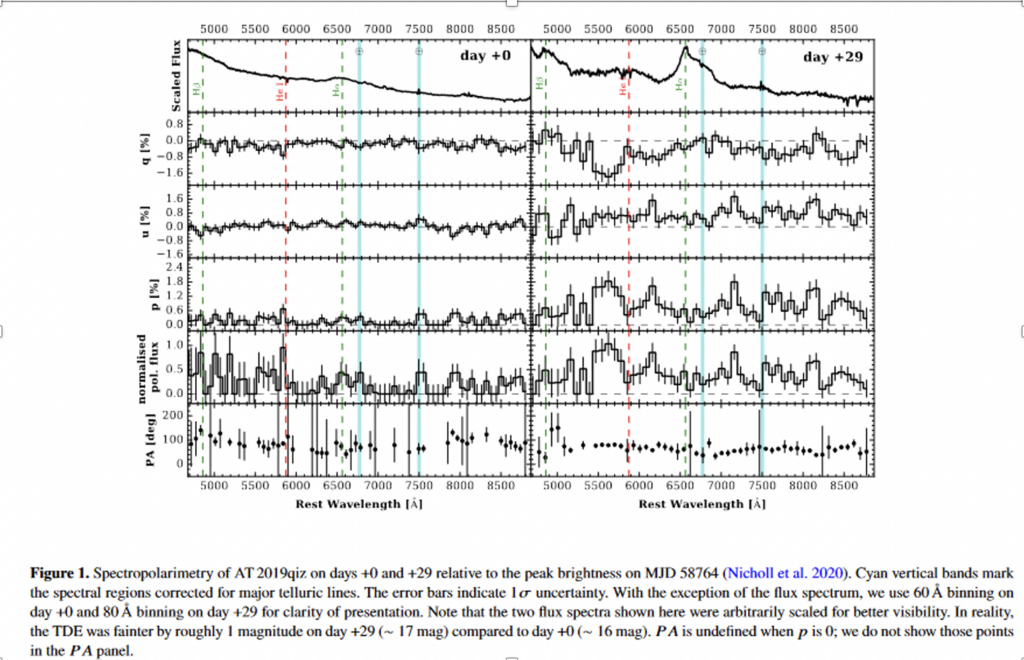TDE Spectroscopy Grants Insight into Unexpected Wavelength Distributions

In September 2019, the closest ever tidal disruption event (TDE), classified as AT2019qiz, was observed at the European Southern Observatory in Chile. However, published in late June 2022, a team of researchers led by Kishore Patra, were able to successfully perform a spectropolarimetric analysis of AT2019qiz, leading to revelations about TDEs regarding their unexpected light curves.
As a star enters the gravitational field of supermassive black hole (SMBH) it will experience tidal forces, caused by the variation in gravitational force acting on the side facing the SMBH and the one facing away. However, TDEs only occur once the two bodies fall within their tidal disruption radius, the distance at which the tidal forces acting on the star exceed its own gravitational binding force. This leads to stellar material stretching along a line leading to the black hole’s centre of mass in a process known as ‘spaghettification.’
Due to the overwhelming gravitational forces, this variation in attraction applied to each side is intense, causing a strain on both bodies, but one that is only noticeable in the less massive star. As the star is unwound, only half of the stellar material remains in bound orbit around the SMBH, falling in and forming an accretion disk. This loss in gravitational potential is then converted into electromagnetic radiation, which are detected as ‘luminous flares.’
When first observing these events, astronomers expected that the intensity-wavelength curve would favour the higher energy region of the spectrum, primarily ultraviolet- and x-rays, as could be observed during similar events, namely active galactic nuclei. However, instead these curves skewed towards the low ultraviolet, high visible range. In response, two theories were devised that aimed to provide an explanation.
The first proposed that these x-rays exist but are instead specifically reprocessed by gas clouds located further outwards from the SMBH. The second suggested that the believed mechanism was in fact false and that instead, the radiation emitted by TDEs was generated by collisions of material in the outer regions of the disk.
AT2019qiz, located at merely 215 million lightyears from Earth, the closest ever recorded, granted us our clearest insight into TDEs ever. It allowed for Patra et al to construct a polarisation-wavelength curve by spectropolarimetry during peak apparent brightness and 29 days after. Immediately, a clear trend could be observed. These lower energy wavelengths, which appeared most intense, emerged unpolarised, during the peak, and were slightly more polarised after the 29-day period. This illustrated the presence of the aforementioned reprocessing cloud, estimated to be spherically symmetric and 200 au in diameter.

As the high energy photons emitted by the TDE passed through this thick cloud, these will polarise during Thompson scattering, while also losing energy in the process. The total polarisation of the photon will be the sum of various ‘electric vectors.’ However, due to the spherical symmetry of the cloud’s surface, these vectors will end up cancelling out, leading to no polarisation. As such, once the photons emerge from the cloud, they have reduced energy and no polarisation. The fall in polarisation led to the conclusion that as this structure began to shed its outermost layer, it exposed its asymmetrical interior, providing a different surface to determine the photon’s final states, leading to slight polarisation.
Despite this, the origin of the gas layer now eludes us, with evidence for theories predating confirmation of the mechanism unable to be found during this particular investigation. The leading explanation involves a complex system out winds causing an outflow of matter from the accretion disk. While it may be a while until such a TDE will occur near enough to perform such comprehensive studies on it again, the team hope that their findings will serve to draw others into pursuing such an opportunity, when it arises again.
----
Cover Image: Interpretation of TDE by Martin Kornmesser
